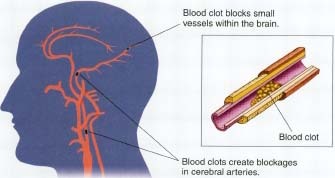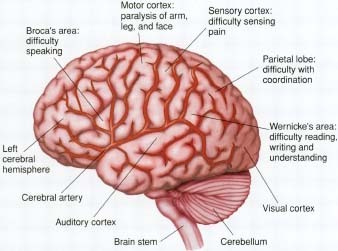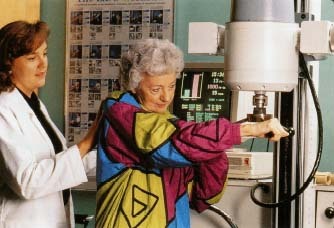Stroke
A stroke is the sudden destruction of brain cells when blood flow to the brain is disrupted, usually by a blockage in a blood vessel. It can cause weakness, speech problems, paralysis, and death, although most people survive.
KEYWORDS
for searching the Internet and other reference sources
Circulatory system
lschemia
Stenosis
Thrombosis
Tissue plasminogen activator (t-PA)
Carmen Visits Her Grandparents
While eating lunch with her grandfather on a sunny afternoon, fourteen-year-old Carmen was in the midst of describing her summer camp plans when suddenly one side of her grandfather's face went slack. He tried to speak, but he was slurring his words. Without warning, he clutched the picnic table, and the drinking glass he held smashed to the ground.
"Grandma!" Carmen called. As her grandmother rushed to dial for emergency aid, Carmen held her grandfather's trembling hand.
In a few minutes, the ambulance arrived to carry him to the hospital, where the doctors quickly ordered a brain scan. The brain scan showed that Carmen's grandfather had undergone an ischemic (is-KEE-mik) stroke. The doctors gave him t-PA, a powerful drug that dissolved a blood clot that was blocking the flow of blood to the brain. In a few days, he was ready to return home. Over several months, with the help of physical, occupational, and speech therapies, Carmen's grandfather was able to make a full recovery.
What Is a Stroke?
A stroke occurs when the blood supply to part of the brain is suddenly interrupted, or when a blood vessel in the brain bursts, spilling blood into the spaces surrounding neurons (nerve cells). Like other cells, brain cells die when they no longer receive oxygen and nutrients from the bloodstream, or when they are damaged by sudden bleeding into or around the brain.
There are two major types of strokes: ischemic strokes involve a reduced blood flow to the brain. Hemorrhagic (hem-o-RAJ-ik) strokes involve bleeding in the brain. Ischemia (is-KEY-me-a) is the term used to describe the loss of oxygen and nutrients when there is inadequate blood flow. If ischemia is left untreated, it can lead to infarction (in-FARK-shun), or cell death and tissue death in the surrounding area.
Ischemic Strokes
Ischemic strokes occur when a blood vessel to the brain becomes blocked, suddenly decreasing or stopping blood flow and ultimately causing an infarction. Ischemic strokes account for approximately 80 percent of all strokes. A blood clot (also called a thrombus) is the most common cause of vessel blockage and brain infarction.

Blood clots
Blood clotting is necessary in the body to stop bleeding and to allow repair of damaged areas, but when blood clots develop in the wrong place within an artery, they can cause injury by stopping the normal flow of blood. Problems with clots develop more frequently as people age.
An embolus is a clot that has formed in a blood vessel somewhere in the body, often in the heart. It can break away from the wall of the vessel where it was formed, travel through the circulatory system, and become wedged in the brain, causing an embolic stroke. Ischemic strokes also can be caused by the formation of a blood clot in one of the cerebral arteries (arteries supplying blood to the brain). If the clot grows large enough it will block blood flow.
Stenosis
Stenosis, or a narrowing of the arteries, also can cause ischemia. Stenosis can occur in large arteries or small arteries, and is called blood vessel disease or small vessel disease. The most common blood vessel disease that causes stenosis is atherosclerosis. Deposits of plaque (a mixture of cholesterol and other fatty substances) build up along the inner walls of larger and medium sized arteries causing thickening, hardening, and loss of elasticity of the artery walls.
Transient ischemic attacks (TIAs)
Some people get a warning that they may be headed for a future stroke. A transient ischemic attack (TIA) is a very small stroke caused by a temporarily blocked blood vessel. Unlike a full stroke, a TIA leaves no permanent damage. Symptoms are similar to those of a full stroke, but they usually last 24 hours or less. It is impossible to know whether the symptoms are caused by a stroke or by a TIA, so any symptoms should receive immediate medical attention. Having a TIA increases the risk of having a full stroke in the future, and medical attention can sometimes prevent or lessen the severity of the stroke.
Hemorrhagic Strokes
Hemorrhagic strokes are caused by burst blood vessels. In a healthy brain, the neurons do not come into direct contact with blood. Oxygen and nutrients move across a membrane from the blood vessel to the brain cells. Neuroglial (noo-ro-GLEE-al) cells help control which fluids and nutrients reach the neurons of the brain. When an artery in the brain bursts, blood spills out into the surrounding tissue, overriding the control of neuro-glial cells and disrupting the delicate chemical balance of the brain.
Hemorrhagic strokes may occur in several ways. Aneurysms, or weak spots on artery walls, can stretch or "balloon" until eventually they break and spill blood into surrounding brain cells. Hemorrhages also can happen when plaque-encrusted arteries lose their elasticity and become brittle and thin enough to crack. Hypertension (high blood pressure) increases the risk that a brittle artery wall will give way and release blood into surrounding brain tissue.
The U.S. and the World
- Stroke is the third leading cause of death in the United States, killing more than 150,000 people each year.
- According to the U.S. Centers for Disease Control and Prevention (CDC), the overall stroke death rate in the U.S. has been declining since 1950.
- The American Heart Association reports that, on average, someone in the U.S. has a stroke every 53 seconds. About 600,000 strokes occur each year, including 100,000 strokes in people who have had at least one previous stroke.
- About 4.4 million people in the U.S. have experienced a stroke and survived.
- Stroke occurs about 20 percent more often in men than in women. But if a woman has a stroke, her chance of dying is about 20 percent higher than a man's chance.
- The World Health Organization (WHO) estimates that strokes killed approximately 5.1 million people worldwide in 1998.
- WHO reports that strokes are increasing worldwide and estimates that stroke and related heart disease could rival infectious disease as the leading cause of death in the developing world by 2020. Reasons cited for the increase include the rise of cigarette smoking as well as changes in diet and lifestyle.
A person who has an arteriovenous (ar-ter-ee-o-VEN-us) malformation (a tangle of defective blood vessels and capillaries within the brain that can rupture) also can be at increased risk for hemorrhagic stroke.

How Do People Know They Are Having a Stroke?
Symptoms of stroke, such as those experienced by Carmen's grandfather, appear suddenly. They may include:
- Numbness or weakness of the face, arm, or leg, particularly on one side.
- Confusion, trouble talking, and trouble understanding speech.
- Difficulty seeing in one or both eyes.
- Dizziness, difficulty walking, loss of balance, or loss of coordination.
- Severe headache with no known cause.
Strokes are medical emergencies and require immediate medical attention.
* CT scans (CAT scans) are computerized axial tomography (to-MOG-ra-fee), which uses x-rays and computers to view structures inside the body.
How Is Stroke Diagnosed?
Doctors have diagnostic techniques and imaging tools to help diagnose strokes quickly and accurately. When a person with signs and symptoms of stroke arrives at the hospital, the first diagnostic step is a physical examination and a medical history. Often, an electrocardiogram and a CT scan * will be done to check for signs of heart disease, evidence of prior TIAs, and heart rhythm disturbances. The patient may be asked to answer questions and to perform several physical and mental tests to evaluate the possibility or severity of brain damage.
Imaging tests also help health care professionals to evaluate stroke. The CT scan may rule out a hemorrhage or may show evidence of early infarction. If the stroke is caused by a hemorrhage, a CT scan can reveal any bleeding into the brain. MRI scans * may be taken to detect subtler changes in brain tissue or areas of dead tissue soon after a stroke.
How Is Stroke Treated?
Stroke treatment often involves medication, surgery, and rehabilitation. Acute stroke therapy uses medication to stop a stroke while it is happening by quickly dissolving the blood clot that is causing the stroke or by stopping the bleeding of a hemorrhagic stroke.
Medication and surgery
Physicians have a number of different medications that can be used to treat stroke:
- Antithrombotics work to counteract the chemicals in the body that cause blood to clot.
- Antiplatelet drugs prevent clotting by decreasing the activity of cells that contribute to the clotting properties of blood. They can reduce the risk of ischemic stroke.
- Anticoagulants reduce the stroke risk by thinning the blood and reducing its clotting properties.
- Thrombolytic agents are used to treat an ongoing stroke. These drugs stop the stroke by dissolving the blood clot that is blocking the blood vessel supplying the brain. Tissue plasminogen activator (t-PA) can be effective if given intravenously within 3 hours of the onset of stroke symptoms when a CT scan confirms that a person has suffered an ischemic stroke.
Surgery may be used to prevent stroke, to treat acute stroke, or to repair vascular malformations in and around the brain.
Rehabilitation
Post-stroke rehabilitation helps people overcome the disabilities that result from stroke damage. For some people, like Carmen's grandfather, acute stroke treatment and post-stroke therapy led to a full recovery. For others, recovery is only partial.
* MRI, which is short for magnetic resonance imaging, produces computerized images of internal body tissues based on the magnetic properties of atoms within the body.
Although strokes occur in the brain, they may affect the entire body and all activities of daily living. Some of the disabilities that may result from a stroke include paralysis, or partial paralysis, of many different parts of the body, difficulties with memory and concentration, speech problems, and emotional distress as people cope with their changed circumstances. Rehabilitation may involve several different forms of therapy:
-
Physical therapy helps people to regain movement, balance, and
coordination and to reestablish skills such as sitting, walking, and
moving from one activity to another.
 Physical therapy helps people who have had strokes regain movement, balance, and muscular coordination.© Will and Deni Mcintyre/Photo Researchers, Inc.
Physical therapy helps people who have had strokes regain movement, balance, and muscular coordination.© Will and Deni Mcintyre/Photo Researchers, Inc. - Occupational therapy helps people who have had strokes readapt to everyday life by relearning practical skills needed at home, such as dressing, eating, bathing, reading, and writing.
- Speech therapy addresses the speech and language problems that arise when a stroke causes brain damage in the language parts of the brain. Speech therapy helps people who have no deficits in cognition or thinking but have problems understanding written words, or problems forming speech. One common problem for people who have suffered stroke is aphasia (a-FAY-zha), a condition in which comprehension or expression of words is impaired. Speech therapists help stroke patients by working to improve language skills, develop alternative ways of communicating, and develop coping skills to deal with the frustration of not being able to communicate easily.
- Psychotherapy often is useful following a stroke, because depression, anxiety, frustration, and anger are common post-stroke symptoms.
Preventing Stroke
The most important risk factors * for stroke are hypertension (high blood pressure), heart disease, diabetes, and smoking. Others things that increase the risk of having a stroke include heavy alcohol consumption, high cholesterol levels, and genetic or congenital conditions, such as vascular (blood vessel) abnormalities.
* risk factors are any factors that make it likelier a person will get a certain disease.
Hypertension
People with hypertension or high blood pressure have a risk for stroke that is four to six times greater than those without hypertension. One third of adults in the United States have high blood pressure. Antihypertensive drugs and attention to diet can decrease a person's risk for stroke.
Heart disease
After hypertension, the second most powerful risk factor for stroke is heart disease, particularly the condition known as atrial fibrillation * . This condition is more prevalent in older people. Other forms of heart disease that can increase the chances of having stroke include malformations of heart muscle and some heart valve diseases. Cardiac surgery to correct heart malformation or the effects of heart disease also can cause stroke. Strokes occurring during surgery often are the result of dislodged plaques.
Diabetes
People with diabetes have three times the risk of stroke as those without diabetes. The relative risk is highest in the fifth and sixth decades of life and decreases after that. People with diabetes who control their blood sugar level well, who avoid smoking, and who avoid or control hypertension, are less likely to have strokes.
Cigarette smoking
Smokers have a 40 to 60 percent greater chance of having a stroke than nonsmokers. Smoking increases a person's chance for ischemic stroke, independent of all other risk factors.
Blood cholesterol levels
High cholesterol levels can contribute to the risk of stroke. Too much cholesterol in the blood is associated with plaque developing in the walls of arteries (atherosclerosis), leading to stenosis of blood vessels. By lowering cholesterol through diet and exercise, a person can lower the risk for atherosclerosis and stroke. Doctors may prescribe cholesterol-lowering medication for people with high cholesterol levels.
Lifestyle changes
Many strokes can be prevented with changes in lifestyle. These changes include:
- Stopping smoking.
- Avoiding binge drinking and overconsumption of alcohol.
- Avoiding illicit drugs: cocaine and crack cocaine can cause stroke, and marijuana may damage blood vessels, which can cause stroke.
* atrial fibrillation (AY-tree-al fib-ri-LAY-shun) is the arrhythmic or irregular beating of the left upper chamber of the heart. This leads to an irregular flow of blood and to the formation of blood clots that can leave the heart and travel to the brain, causing a stroke.
Ike
Dwight D. Eisenhower (1890—1969) was a U.S. Army general and the thirty-fourth president of the United States. "Ike," as he was known, had a meteoric rise as a military commander during World War II. In 1953, he was elected to his first term in the White House. Despite having a stroke and a heart attack, he was elected to a second term. Eisenhower completed his presidency in 1961, when John F. Kennedy was sworn in as thirty-fifth president.
Medical measures
To prevent stroke, doctors may prescribe medications to lower blood pressure and cholesterol levels. In some cases, particularly if a person has atrial fibrillation, doctors may prescribe regular doses of aspirin, coumadin, or other medications that prevent blood clotting. If carotid (ka-ROT-id) arteries (arteries supplying the brain) are partially blocked by plaque, surgery can clear them and prevent strokes in many cases.
Strokes can happen to people of either sex no matter what their age or racial background. Transient ischemic attacks (TIAs) multiply a person's risk of having a full stroke and should receive immediate medical attention.
See also
Aneurysm
Diabetes
Dysrhythmia
Heart Disease
Hypertension
Paralysis
Speech Disorders
Substance Abuse
Thrombosis
Resources
U.S. National Institute of Neurological Disorders and Stroke (NINDS),
Building 31, Room 8A16, 31 Center Drive, MSC 2540, Bethesda, MD
20892-2540. The NINDS website posts many useful fact sheets about
stroke, with information on stroke prevention, treatment, research, and
clinical trials.
Telephone 800-352-9424
http://www.ninds.nih.gov/patients/Disorder/STROKE/strokehp.htm
National Stroke Association, 96 Inverness Drive East, Suite 1,
Englewood, CO 80112-5112.
Telephone 800-787-6537
http://www.stroke.org
American Heart Association, 7272 Greenville Avenue, Dallas, TX 75231.
http://www.amhrt.org
World Health Organization (WHO), Avenue Appia 20, 1211 Geneva 27,
Switzerland. WHO's website posts information about stroke and
other non-communicable diseases worldwide.
http://www.who.org/home/map_ht.html
Comment about this article, ask questions, or add new information about this topic: